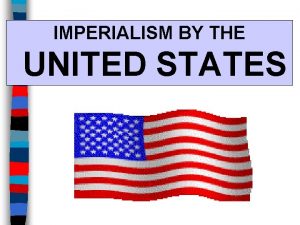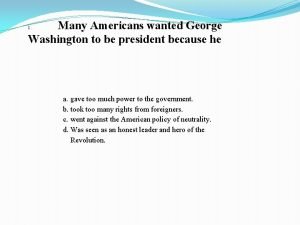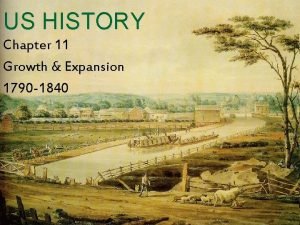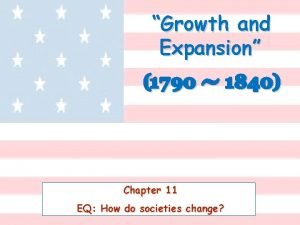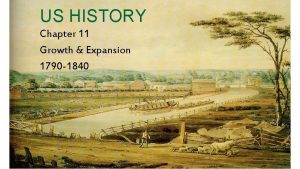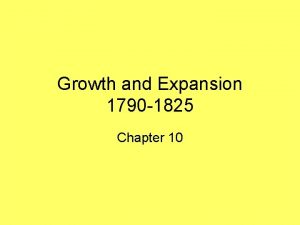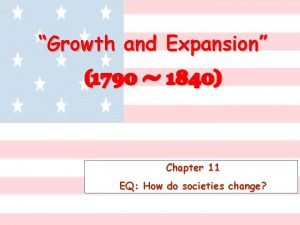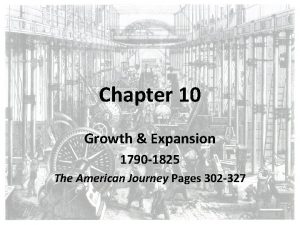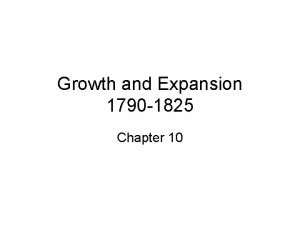US HISTORY Chapter 11 3 Growth Expansion 1790













- Slides: 13

US HISTORY Chapter 11. 3 Growth & Expansion 1790 -1840

n Lesson 3 – Unity and Era of Good. Sectionalism Feelings q q Occurred during the presidency of James Monroe (post-War of 1812 through the early 1820 s) Time in the nation when everyone seemed to get along support for the govt. was very high

n Lesson 3 – Unity and American System Sectionalism q q q Proposal by House Speaker Henry Clay to help the U. S. grow. Included higher tariffs, a new Bank of the United States, and internal improvements. Not all Americans agreed with the plan and led to sectionalism.


Lesson 3 – Unity and Competition from Britain Sectionalism n q The Second Bank of the United States restored order to the money supply, helping American businesses to grow.

Lesson 3 – Unity and Sectionalism n q q q Sectionalism – loyalty to a particular region, or section, of the country. Three distinct sections of the country were: the North, the South, and the West. John C. Calhoun – (South Carolina) became a strong opponent of national programs and a supporter of states having the right to govern themselves. . . very vocal leader from the South, becomes a national figure up to the Civil War.

Lesson 3 – Unity and Sectionalism Daniel Webster – n q q (Massachusetts) known as a great public speaker, protected interests of New England. Henry Clay – (Kentucky) tried to resolve sectional disputes through compromise. Later became known as “The Great Compromiser”.

n Lesson 3 – Unity and Nationalism. Sectionalism & U. S. Supreme Court q 1. 2. 3. Early 1800 s – U. S. Supreme Court strengthened the national government’s power over the states. Fletcher v Peck (1810)- Supreme Court ruled that courts could declare acts of a state government void if they violated provisions of the Constitution. Mc. Culloch v Maryland (1819) – S. C. said the State of Maryland could NOT tax a local office of the Bank of the United States because that would give the state power over the national government. Gibbons v Ogden (1824) – S. C. said that only the national government could make laws governing interstate commerce, NOT the states.

n Lesson 3 – Unity and The Missouri Compromise (1820) Sectionalism q q South wanted Missouri admitted as a slave state, Maine had also applied for statehood. Compromise developed by Henry Clay: n n n 1) Missouri joins as a slave state. 2) Maine joins as a free state. 3) Slavery was banned north of the 36° 30’ parallel.

USA and Spain Under what treaty did Spain finally give up Florida to the United States? q q With the Adams-Onis Treaty of 1819, Spain ceded, or gave up control of, all claims and ownership to both East and West Florida. They also gave up claims to Oregon Country in the Pacific Northwest, while the U. S. agreed to Spanish control of Texas.

The Monroe Doctrine • In 1822 four European nations. France, Austria, Russia, and Prussia- discussed a plan to help Spain regain its American holdings. • The possibility of increased European involvement in the Americas troubled President James Monroe.

The Monroe Doctrine • President James Monroe first introduced the Monroe Doctrine during his State of the Union Address to Congress on December 2, 1823. • • The doctrine established the foreign policy of the United States regarding the Western Hemisphere. Presidents throughout history invoked the Monroe Doctrine when intervening in foreign affairs in the Western Hemisphere.

The Monroe Doctrine Activity 1. In your groups, summarize parts 2 and 3 of the Monroe Doctrine. 2. Based on the information gathered, create a political cartoon that explains the Monroe Doctrine visually.
 1790 foreign policy
1790 foreign policy Imperialism
Imperialism Coquille meaning
Coquille meaning Which statement best characterizes american farmers in 1790
Which statement best characterizes american farmers in 1790 Lesson 2 moving west
Lesson 2 moving west Chapter 11 growth and expansion vocabulary
Chapter 11 growth and expansion vocabulary Relative growth rates
Relative growth rates Monocots vs eudicots
Monocots vs eudicots Growthchain
Growthchain Primary growth and secondary growth in plants
Primary growth and secondary growth in plants Vascular ray
Vascular ray Geometric exponential growth
Geometric exponential growth Neoclassical growth theory vs. endogenous growth theory
Neoclassical growth theory vs. endogenous growth theory Difference between organic and inorganic growth
Difference between organic and inorganic growth

